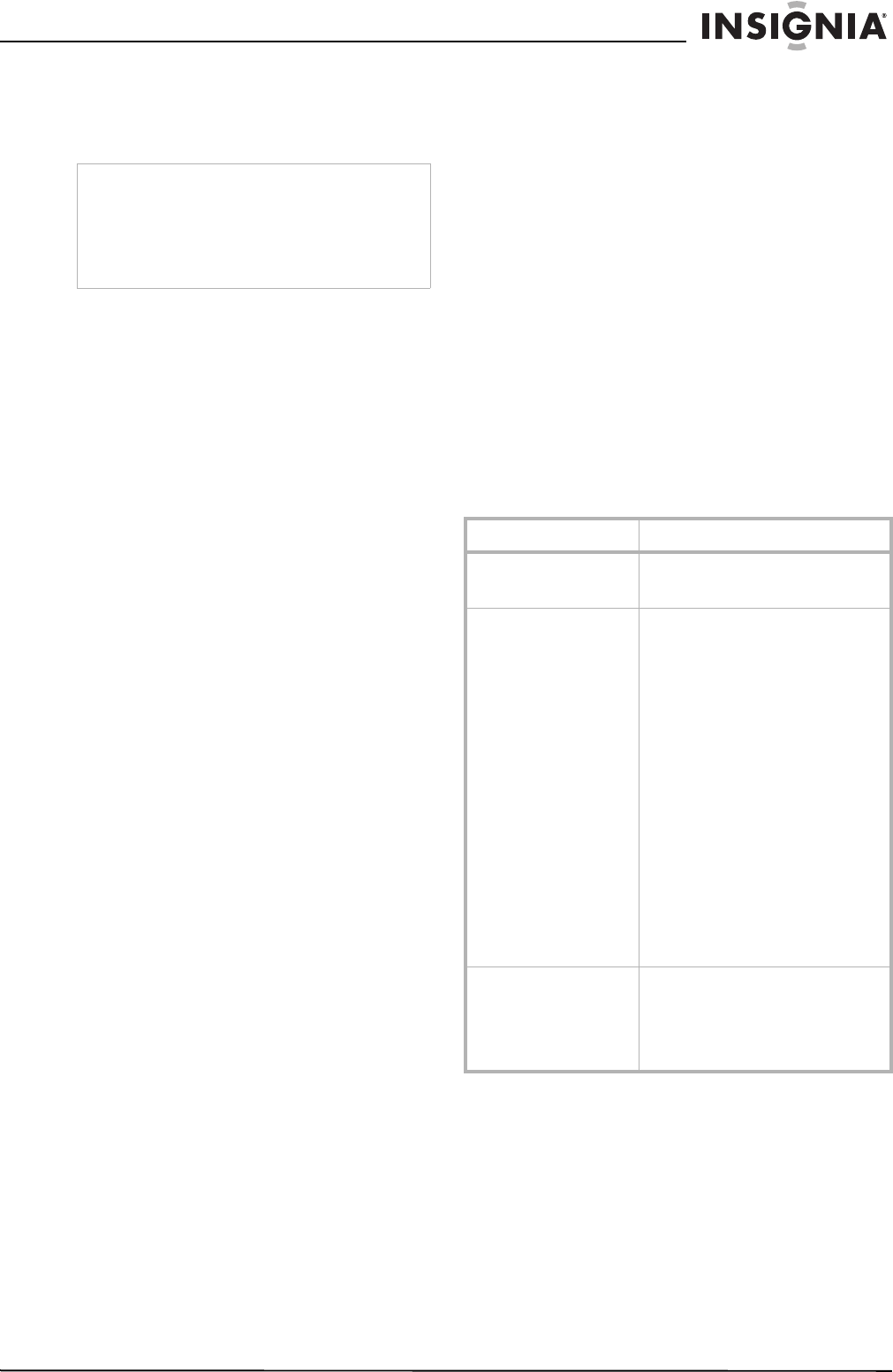
9
Insignia NS-DPF8/NS-DPF10 Digital Picture Frame
www.insignia-products.com
2 Select the files you want to copy, click File,
then click Copy.
3 Click in the window for the removable card,
click File, then click Paste.
Disconnecting the digital picture frame from a
Windows computer
It is important not to just unplug the digital
picture frame when you are done transferring
files. It can seriously damage the built-in
memory.
To disconnect from a Windows computer:
1 Right-click the USB icon in the task tray, then
click Safely Remove Hardware. A dialog box
opens.
2 Click USB Mass Storage Device, then click
Stop. Another dialog box opens.
3 Click OK. Another dialog box opens.
4 Click Close. When the message It is Now
Safe to Disconnect Hardware appears, you
can disconnect the USB cable from your
computer.
Connecting to a Macintosh computer
You can copy files from your Macintosh
computer to your digital picture frame.
To connect to a Macintosh computer:
1 Plug in and turn on the digital picture frame.
2 Connect the small end of the USB cable to
the USB port on the side of the digital picture
frame.
3 Connect the larger end of the USB cable to a
USB port on your Macintosh computer. The
Macintosh will recognize the digital picture
frame as an external storage device.
4 Drag and drop files between the two devices
as you normally move photo files.
Disconnecting the digital picture frame from a
Macintosh computer
To safely disconnect the digital picture frame
from your Macintosh:
1 Select the digital picture frame's icon on your
desktop, then press Command-e to eject the
disk.
2 When the icon is no longer on the desktop,
unplug the USB cable.
Connect a USB flash drive
Your digital picture frame uses a USB flash drive
the same way it uses memory cards.
Maintaining your digital
picture frame
Cleaning the LCD Screen
Treat the screen gently. The screen is made of
glass and can be scratched or broken.
To clean fingerprints or dust from the LCD
screen, we recommend using the cloth provided
or a soft, non-abrasive cloth such as a camera
lens cloth.
If you use a commercial LCD cleaning kit, do not
apply the cleaning liquid directly to the LCD
screen. Clean the LCD screen with the cleaning
cloth moistened with the liquid.
Cleaning the digital picture frame
Clean the outer surface of the digital picture
frame (excluding the screen) with a soft cloth
dampened with water.
Troubleshooting
Note
If your PC is connected to Local Area Network
drives, or if you have multiple drive letters already
assigned to peripheral devices, you need to
manage your drive settings in Windows to free up
the four drive letters immediately following your
CD-ROM drive so the Digital Photo Frame can
assign them to memory card slots.
Problem Solution
The digital picture frame
won't turn on.
The adapter is not securely connected
to the picture frame or the power
switch is not on.
A memory card is
inserted in the digital
picture frame but you
can’t view your photos.
• Make sure that the memory card
is one of the supported formats
and that the files on the card are
JPEG images files.
• Turn the digital picture frame off
and make sure that the memory
card is inserted all the way into
the card slot and is inserted
correctly.
• Turn the frame on. After a couple
of seconds, you should see your
first photo. Press EXIT to open
the Select Card screen. Select the
card, then select Photos. You
should see the Thumbnails
screen listing all photos on the
card. If you don't, you may want
to try another card.
Note: Some digital cameras save
images in formats other than JPEG.
Refer to your camera's manual if your
photos are not JPEG files.
The picture displays some
pictures slower and some
pictures faster
Higher resolution pictures load more
slowly. Try using lower resolution
pictures or down sampling your
images. See your camera's operating
manual for details on down sampling
your photos.
